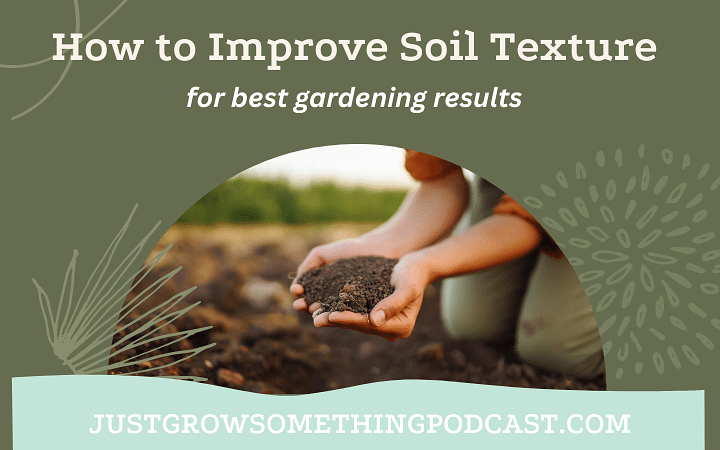
The foundation of a thriving garden lies beneath our feet – the soil. Healthy soil is not only rich in nutrients but also has a texture that allows roots to easily penetrate and access those nutrients. Soil texture refers to the size of mineral particles within the soil – the sand, silt, and clay. Not all of us live in areas that naturally have the ideal ratio of those particles. Amending the garden soil can be a game-changer for gardeners with less-than-ideal soil, promoting better water retention, drainage, and root development.
 Organic Matter: The Soil's Best Friend
Organic Matter: The Soil's Best Friend
Compost: One of the most valuable amendments for improving soil texture is compost. Compost is a nutrient-rich, organic material created through the decomposition of kitchen scraps, yard waste, and other organic matter. When added to soil, compost improves its structure by increasing its ability to hold moisture and nutrients while also promoting aeration. This encourages the growth of beneficial soil organisms, such as earthworms, which further enhance soil texture.
Leaf Litter: Fallen leaves are a free and abundant resource for gardeners. Shredded leaves can be spread directly on garden beds to improve soil texture over time. As they break down, they add organic matter, increase soil biodiversity, and create a loose, crumbly texture ideal for plant roots.
Grass Clippings: After mowing your lawn, consider using grass clippings as a mulch or soil amendment. Grass clippings break down quickly, adding nitrogen and organic matter to the soil. However, it's important to use them in thin layers to prevent matting, which can impede water and air movement.
Leaf Mold: Leaf mold is another excellent soil conditioner. Unlike compost, which requires active decomposition, leaf mold is the result of leaves decomposing slowly over time in a moist, shaded area. This process creates a dark, crumbly material that improves soil structure and provides a habitat for beneficial microorganisms.
Sphagnum Peat Moss: Peat moss is a fully natural and organic fibrous growing medium that comes from sphagnum, a group of plants that grow in cold marshes. It can improve the texture and drainage of clay soils and improve the water- and nutrient-holding capacity of sandy ones. It also helps to acidify alkaline soils, those with a pH higher than 7.0. While peat moss has excellent properties, it’s essential to be aware of its environmental impact. Be aware that peat moss harvesting can have adverse effects on ecosystems, especially in sensitive bog habitats. Sustainable harvesting methods are crucial to conserve peat bogs and maintain ecological balance. Look for Canadian peat moss; their government regulates the percentage of virgin bogs that can be harvested each year and mandates sustainable practices.
Cover Crops: Nature's Soil Builders
Cover crops are plants grown specifically to improve soil health. They offer a multitude of benefits, including enhancing soil texture by adding organic matter, breaking up compacted soil, and preventing erosion. Here are some common cover crops and their soil-enhancing properties:
Legumes (e.g., clover, vetch): Legumes are nitrogen-fixing plants, meaning they have the ability to take nitrogen from the air and convert it into a form that plants can use. When these cover crops are incorporated into the soil, they not only add organic matter but also increase nitrogen levels, benefiting future crops.
Buckwheat: Buckwheat is a fast-growing cover crop that excels at suppressing weeds and maintaining soil moisture. Buckwheat fits in well as a summer cover crop, after early vegetables have been harvested and before fall-planted vegetables After flowering, buckwheat can be easily incorporated into the soil, where it decomposes rapidly, releasing nutrients. Or you can chop it and drop it to act as a mulch for a fall crop.
Winter Rye: Winter rye is a hardy cover crop that can be sown in the fall and left to overwinter. In the spring, it continues to grow, producing extensive root systems that help break up compacted soil. As it decomposes, winter rye adds organic matter and nutrients to the soil, preparing it for planting.
Tips for Using Organic Matter and Cover Crops Effectively
- Apply in Layers: When adding organic matter like compost, leaf litter, or grass clippings, it's best to apply them in layers rather than all at once. This allows for even distribution and prevents clumping.
- Mix Cover Crops: For optimal results, consider mixing different types of cover crops. This can provide a diverse range of benefits, such as improved soil structure, nutrient cycling, and weed suppression.
- Rotate Cover Crops: Rotate cover crops each season to maximize their benefits. For example, legumes can be followed by grasses to balance nitrogen levels and organic matter content in the soil.
- Allow for Decomposition: Whether it's compost or cover crops, give organic matter time to decompose before planting. This ensures that nutrients are readily available to plants and helps build long-term soil health.
Improving soil texture is a cornerstone of successful gardening, and organic matter and cover crops are powerful tools in achieving this goal. By incorporating compost, leaf litter, grass clippings, leaf mold, and diverse cover crops, gardeners can create soil that is rich in nutrients, well-structured, and teeming with life.
Your Friend in the Garden,

